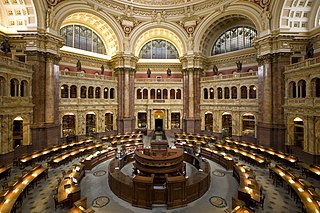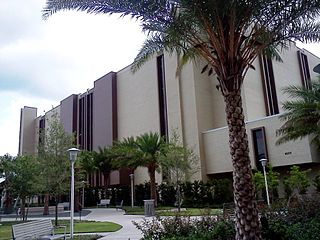Related Research Articles
Interlibrary loan is a service whereby a patron of one library can borrow books, DVDs, music, etc. and/or receive photocopies of documents that are owned by another library. The user makes a request with their home library; which, acting as an intermediary, identifies libraries with the desired item, places the request, receives the item, makes it available to the user, as well as arranges for its return. The lending library usually sets a due date and overdue fees of the material borrowed. Although books and journal articles are the most frequently requested items, some libraries will lend audio recordings, video recordings, maps, sheet music, and microforms of all kinds. In some cases, nominal fees accompany the interlibrary loan services.
This page is a glossary of library and information science.

A research library is a library which contains an in-depth collection of material on one or several subjects. A research library will generally include an in-depth selection of materials on a particular topic or set of topics and contain primary sources as well as secondary sources. Research libraries are established to meet research needs and as such are stocked with authentic materials with quality content. Research libraries are typically attached to academic or research institutions that specialize in that topic and serve members of that institution. Large university libraries are considered research libraries, and often contain many specialized branch research libraries. The libraries provide research materials for students and staff of these organizations to use and can also publish and carry literature produced by these institutions and make them available to others. Research libraries could also be accessible to members of the public who wish to gain in-depth knowledge on that particular topic.

The Federal Depository Library Program (FDLP) is a government program created to make U.S. federal government publications available to the public at no cost. As of April 2021, there are 1,114 depository libraries in the United States and its territories. A "government publication" is defined in the U.S. Code as "informational matter which is published as an individual document at Government expense, or as required by law".
Landsbókasafn Íslands – Háskólabókasafn is the national library of Iceland which also functions as the university library of the University of Iceland. The library was established on December 1, 1994 in Reykjavík, Iceland, with the merger of the former national library, Landsbókasafn Íslands, and the university library. It is the largest library in Iceland with about one million items in various collections. The library's largest collection is the national collection containing almost all written works published in Iceland and items related to Iceland published elsewhere. The library is the main legal deposit library in Iceland. The library also has a large manuscript collection with mostly early modern and modern manuscripts, and a collection of published Icelandic music and other audio. The library houses the largest academic collection in Iceland, most of which can be borrowed for off-site use by holders of library cards. University students get library cards for free, but anyone can acquire a card for a small fee. The library is open for public access.
Library collection development is the process of systematically building the collection of a particular library to meet the information needs of the library users in a timely and economical manner using information resources locally held as well as resources from other organizations.
The California Digital Library (CDL) was founded by the University of California in 1997. Under the leadership of then UC President Richard C. Atkinson, the CDL's original mission was to forge a better system for scholarly information management and improved support for teaching and research. In collaboration with the ten University of California Libraries and other partners, CDL assembled one of the world's largest digital research libraries. CDL facilitates the licensing of online materials and develops shared services used throughout the UC system. Building on the foundations of the Melvyl Catalog, CDL has developed one of the largest online library catalogs in the country and works in partnership with the UC campuses to bring the treasures of California's libraries, museums, and cultural heritage organizations to the world. CDL continues to explore how services such as digital curation, scholarly publishing, archiving and preservation support research throughout the information lifecycle.
Serials Solutions was a division of ProQuest that provided e-resource access and management services (ERAMS) to libraries. These products enabled librarians to more easily manage electronic resources that serve the needs of their users. Serials Solutions became part of ProQuest Workflow Solutions in 2011 and the "Serials Solutions" name was retired in 2014. In 2015, Proquest acquired Ex Libris Group, a library automation company with many similar products to those of ProQuest Workflow Solutions. The Workflow Solutions division was to be merged with Ex Libris into a new business group called Ex Libris, a ProQuest Company.

Project MUSE, a non-profit collaboration between libraries and publishers, is an online database of peer-reviewed academic journals and electronic books. Project MUSE contains digital humanities and social science content from over 250 university presses and scholarly societies around the world. It is an aggregator of digital versions of academic journals, all of which are free of digital rights management (DRM). It operates as a third-party acquisition service like EBSCO, JSTOR, OverDrive, and ProQuest.
Library Technical Services are the ongoing maintenance activities of a library's collection, including the three broad areas of collection development, cataloging, and processing. Technical services are the infrastructure that enable the user's experience of many library services and are typically performed "behind the scenes."
ERAMS are a way of thinking about library management to help libraries optimize the access, usage, data, and workflows of electronic library collections in the physical and digital library.

The National Art Library (NAL) is a major reference library, situated in the Victoria and Albert Museum (V&A), a museum of decorative arts in London. The NAL holds the UK's most comprehensive collection of both books as art and books about art, which includes many genres and time periods. The NAL is open to the public, and as a closed reference library, items must be requested through the staff and cannot be removed from the reading room. The collections cover a wide range of art and design topics, including books about artists and art techniques, and consists of many different collections materials, including archival materials, artist's books, and children's literature. The library also serves as the museum's curatorial department for book arts. As a reference library, the NAL also serves as a training library for students, curators and museum staff, and the public.
Electronic resource management (ERM) is the practices and techniques used by librarians and library staff to track the selection, acquisition, licensing, access, maintenance, usage, evaluation, retention, and de-selection of a library's electronic information resources. These resources include, but are not limited to, electronic journals, electronic books, streaming media, databases, datasets, CD-ROMs, and computer software.
A digital library, also called an online library, an internet library, a digital repository, or a digital collection is an online database of digital objects that can include text, still images, audio, video, digital documents, or other digital media formats or a library accessible through the internet. Objects can consist of digitized content like print or photographs, as well as originally produced digital content like word processor files or social media posts. In addition to storing content, digital libraries provide means for organizing, searching, and retrieving the content contained in the collection. Digital libraries can vary immensely in size and scope, and can be maintained by individuals or organizations. The digital content may be stored locally, or accessed remotely via computer networks. These information retrieval systems are able to exchange information with each other through interoperability and sustainability.
An inventory is the one method that libraries and archives use to determine whether some items in their collection are in need of preservation or conservation activities. A modern inventory might involve examining item by item with a barcode scanner and a laptop, with the objective of adjusting bibliographic and item records in theirs and OCLC's WorldCat databases. Using a laptop and handheld bar code reader will "reduce human error and inconsistencies, while helping to maintain staff concentration and enthusiasm for the project".
A library consortium is any cooperative association of libraries that coordinates resources and/or activities on behalf of its members, whether they are school, public, academic, special libraries and/or information centers. Consortia exist on a variety of levels, e.g., local, state, regional, national or international. Libraries commonly belong to multiple consortia. The goal of a library consortium is to amplify the capabilities and effectiveness of its member libraries through collective action, including, but not limited to, print or electronic resource sharing, reductions in costs through group purchases of resources, and professional development opportunities. The “bedrock principle upon which consortia operate is that libraries can accomplish more together than alone.”
E-book lending or elending is a practice in which access to already-purchased downloads or online reads of e-books is made available on a time-limited basis to others. It works around the digital rights management built into online-store-published e-books by limiting access to a purchased e-book file to the borrower, resulting in loss of access to the file by the purchaser for the duration of the borrowing period.

The Elyachar Central Library is the central body in the Technion library system. As such, it has a dual role: to provide an infrastructure for all the Technion libraries and to provide various services to its patrons. The Central Library determines policies and guidelines for all the Technion libraries. The library's building is located in the heart of the Nave-Shaanan Campus in Haifa. Funding for the building was contributed by Colonel Jehiel Elyachar and the library is named after him.

The University of South Florida Tampa Library is the main research library for the University of South Florida. Housing over 1.3 million books, academic journals and electronic resources, including 52,000 e-journal subscriptions, 443,000 e-books, and over 800 databases, the library has more than 2 million visitors each year. The library offers tutoring and writing services, laptops, a career resource center, and course reserves. The facility houses several special and digital collections, including literature, oral histories, photographs, artifacts, and the university archives. The current Dean of USF Libraries is Todd Chavez.
The Boston Library Consortium (BLC) is a library consortium based in the Boston area with 20 member institutions across New England.
References
- ↑ Esposito, Joseph (15 October 2014). "Revisiting Demand-driven Acquisitions". The Scholarly Kitchen.
- ↑ Anderson, Rick (31 May 2011). "What Patron-Driven Acquisition (PDA) Does and Doesn't Mean: An FAQ". The Scholarly Kitchen.
- 1 2 Swords, David (2011). Patron-Driven Acquisitions: History and Best Practices. Berlin: Walter de Gruyter. ISBN 9783110253030.
- ↑ Esposito, Joseph J; Walker, Kizer; Ehling, Terry (16 October 2012). "PDA and the University Press". pp. 39–43. Retrieved 5 January 2017.
- 1 2 Fischer, K. S.; Wright, M.; Clatanoff, K.; Barton, H.; Shreeves, E. (22 September 2011). "Give 'Em What They Want: A One-Year Study of Unmediated Patron-Driven Acquisition of e-Books". College & Research Libraries. 73 (5): 469–492. doi: 10.5860/crl-297 .